Solar eclipse of April 29, 1995
An annular solar eclipse occurred on April 29, 1995. A solar eclipse occurs when the Moon passes between Earth and the Sun, thereby totally or partly obscuring the image of the Sun for a viewer on Earth. An annular solar eclipse occurs when the Moon's apparent diameter is smaller than the Sun's, blocking most of the Sun's light and causing the Sun to look like an annulus (ring). An annular eclipse appears as a partial eclipse over a region of the Earth thousands of kilometres wide. Annularity was visible in Peru, southeastern Ecuador, southeastern Colombia and Brazil.
| Solar eclipse of April 29, 1995 | |
|---|---|
 Map | |
| Type of eclipse | |
| Nature | Annular |
| Gamma | -0.3382 |
| Magnitude | 0.9497 |
| Maximum eclipse | |
| Duration | 397 sec (6 m 37 s) |
| Coordinates | 4.8°S 79.4°W |
| Max. width of band | 196 km (122 mi) |
| Times (UTC) | |
| Greatest eclipse | 17:33:20 |
| References | |
| Saros | 138 (30 of 70) |
| Catalog # (SE5000) | 9497 |
Images
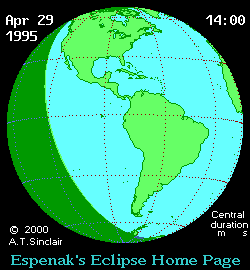
Related eclipses
Eclipses of 1995
Solar eclipses 1993–1996
This eclipse is a member of a semester series. An eclipse in a semester series of solar eclipses repeats approximately every 177 days and 4 hours (a semester) at alternating nodes of the Moon's orbit.[1]
| Solar eclipse series sets from 1993–1996 | ||||||
|---|---|---|---|---|---|---|
| Descending node | Ascending node | |||||
| Saros | Map | Gamma | Saros | Map | Gamma | |
| 118 | 1993 May 21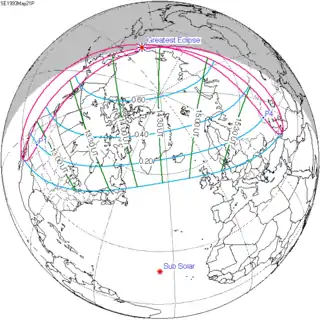 Partial | 1.13720 | 123 | 1993 November 13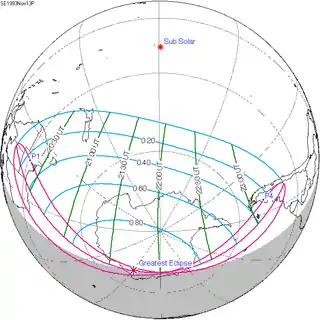 Partial | -1.04114 | |
| 128 | 1994 May 10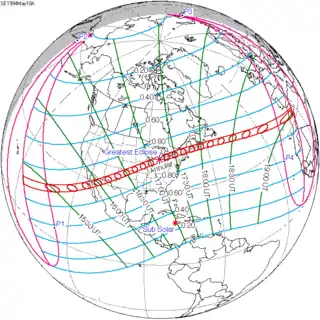 Annular | 0.40771 | 133.jpg.webp) Totality at Bolivia | 1994 November 3 Total | -0.35216 | |
| 138 | 1995 April 29 Annular | -0.33821 | 143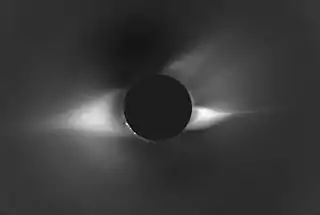 Totality at Dundlod, India | 1995 October 24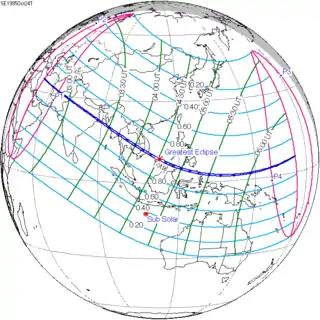 Total | 0.35176 | |
| 148 | 1996 April 17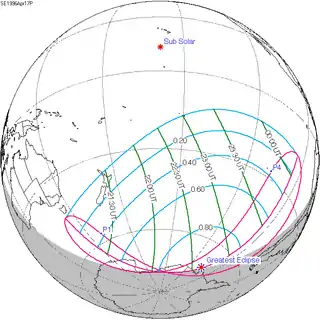 Partial | -1.05796 | 153 | 1996 October 12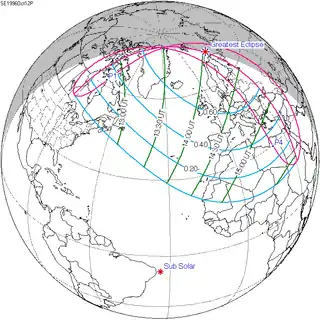 Partial | 1.12265 | |
Saros 138
It is a part of Saros cycle 138, repeating every 18 years, 11 days, containing 70 events. The series started with partial solar eclipse on June 6, 1472. It contains annular eclipses from August 31, 1598 through February 18, 2482 with a hybrid eclipse on March 1, 2500. It has total eclipses from March 12, 2518 through April 3, 2554. The series ends at member 70 as a partial eclipse on July 11, 2716. The longest duration of totality will be only 56 seconds on April 3, 2554.
| Series members 25–35 occur between 1901 and 2100: | ||
|---|---|---|
| 25 | 26 | 27 |
 March 6, 1905 |
 March 17, 1923 |
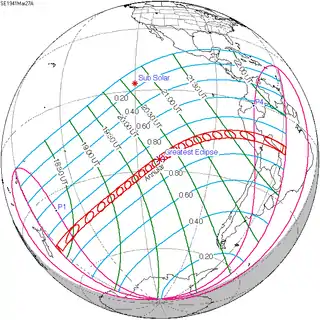 March 27, 1941 |
| 28 | 29 | 30 |
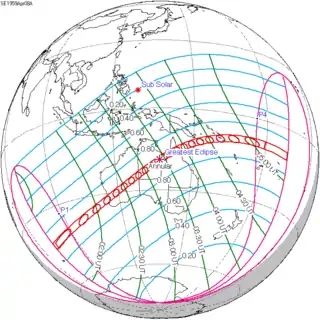 April 8, 1959 |
 April 18, 1977 |
 April 29, 1995 |
| 31 | 32 | 33 |
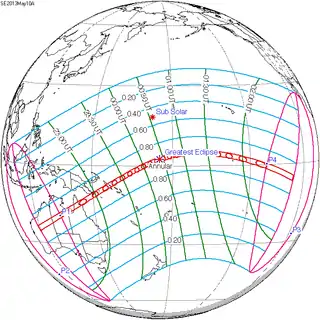 May 10, 2013 |
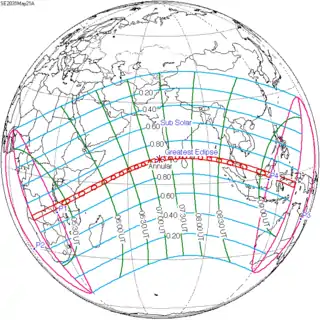 May 21, 2031 |
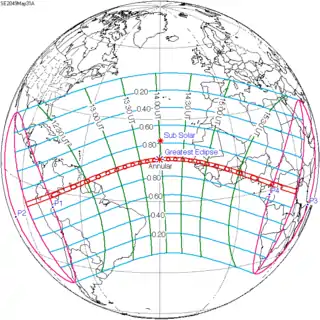 May 31, 2049 |
| 34 | 35 | |
 June 11, 2067 |
 June 22, 2085 | |
Metonic series
The metonic series repeats eclipses every 19 years (6939.69 days), lasting about 5 cycles. Eclipses occur in nearly the same calendar date. In addition, the octon subseries repeats 1/5 of that or every 3.8 years (1387.94 days). All eclipses in this table occur at the Moon's descending node.
| 21 eclipse events, progressing from north to south between July 11, 1953 and July 11, 2029 | ||||
|---|---|---|---|---|
| July 10–12 | April 29–30 | February 15–16 | December 4–5 | September 21–23 |
| 96 | 98 | 100 | 102 | 104 |
| July 12, 1915 | April 30, 1919 | February 15, 1923 | December 5, 1926 | September 22, 1930 |
| 106 | 108 | 110 | 112 | 114 |
| July 11, 1934 | April 30, 1938 | February 15, 1942 | December 4, 1945 | September 22, 1949 |
| 116 | 118 | 120 | 122 | 124 |
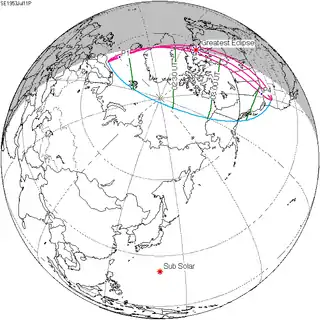 July 11, 1953 |
 April 30, 1957 |
 February 15, 1961 |
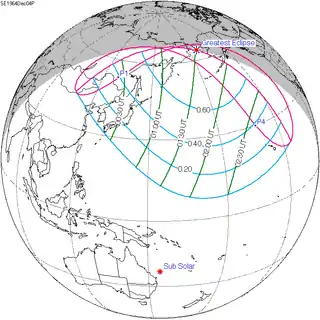 December 4, 1964 |
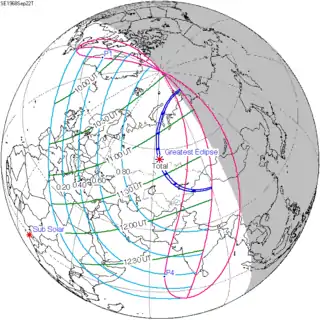 September 22, 1968 |
| 126 | 128 | 130 | 132 | 134 |
 July 10, 1972 |
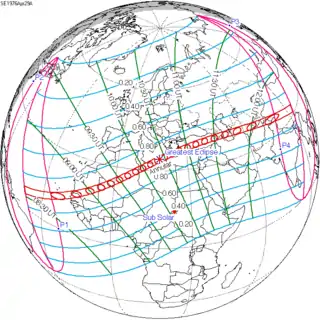 April 29, 1976 |
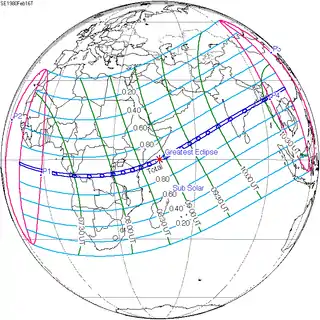 February 16, 1980 |
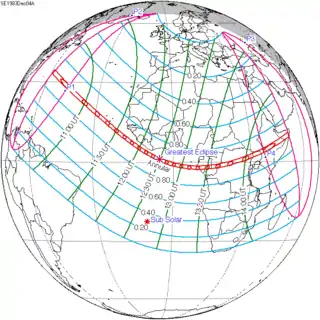 December 4, 1983 |
 September 23, 1987 |
| 136 | 138 | 140 | 142 | 144 |
 July 11, 1991 |
 April 29, 1995 |
 February 16, 1999 |
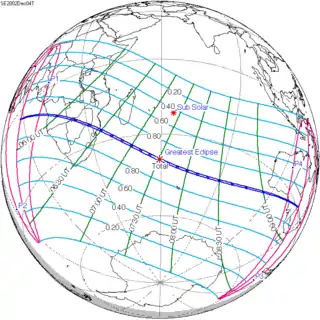 December 4, 2002 |
 September 22, 2006 |
| 146 | 148 | 150 | 152 | 154 |
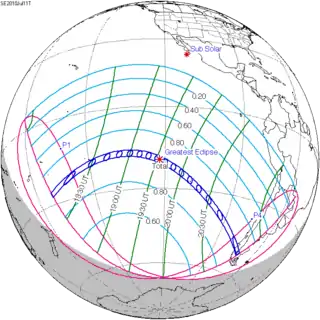 July 11, 2010 |
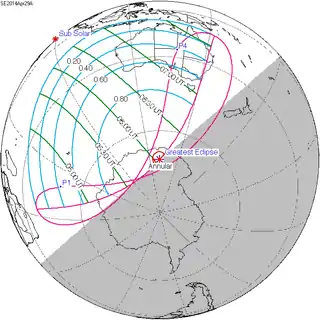 April 29, 2014 |
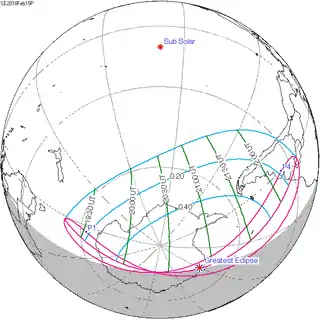 February 15, 2018 |
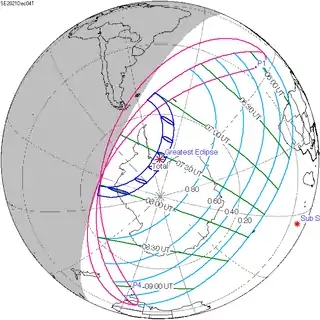 December 4, 2021 |
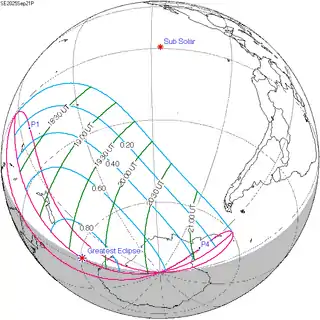 September 21, 2025 |
| 156 | 158 | 160 | 162 | 164 |
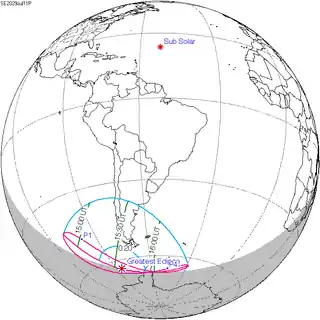 July 11, 2029 |
April 29, 2033 | February 15, 2037 | December 4, 2040 | September 21, 2044 |
References
- van Gent, R.H. "Solar- and Lunar-Eclipse Predictions from Antiquity to the Present". A Catalogue of Eclipse Cycles. Utrecht University. Retrieved 6 October 2018.
External links
- Earth visibility chart and eclipse statistics Eclipse Predictions by Fred Espenak, NASA/GSFC
Photos:
.jpg.webp)

